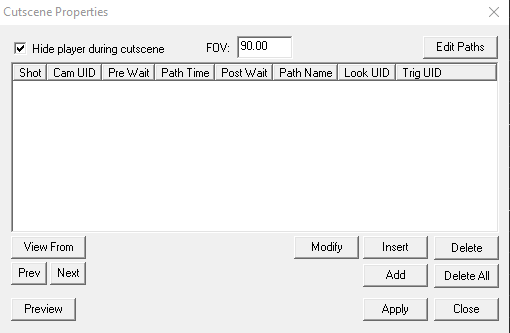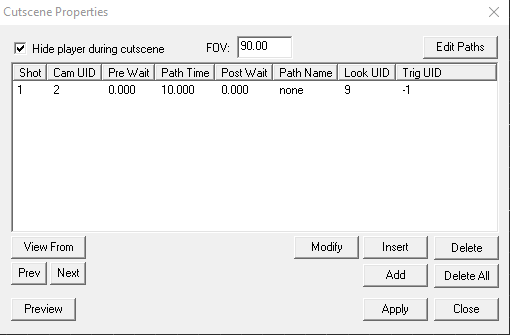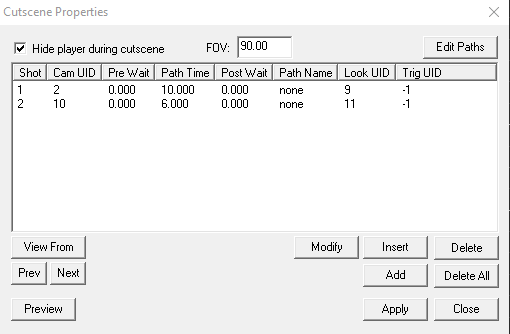Cutscene Tutorial: Difference between revisions
Beatonator (talk | contribs) No edit summary |
|||
| (10 intermediate revisions by one other user not shown) | |||
| Line 3: | Line 3: | ||
This page will detail the various settings we know about the Cutscene Creation and a basic guide on creating Camera paths. | This page will detail the various settings we know about the Cutscene Creation and a basic guide on creating Camera paths. | ||
THIS PAGE IS A WORK IN PROGRESS! | '''THIS PAGE IS A WORK IN PROGRESS!''' | ||
== Cutscene Information == | == Cutscene Information == | ||
=== Cutscene Properties === | === Cutscene Properties === | ||
{| class="wikitable" | |||
|+ | |||
|- | |||
|[[File:img_cutscene_properties01.png]] | |||
|- | |||
|} | |||
=== Camera Properties === | === Camera Properties === | ||
| Line 17: | Line 25: | ||
* Look UID - This property makes the camera focus/follow on a specific object. | * Look UID - This property makes the camera focus/follow on a specific object. | ||
* Trigger UID - TBD... Unsure, possibly used to trigger another event? | * Trigger UID - TBD... Unsure, possibly used to trigger another event? | ||
== Creating a Basic Cutscene == | == Creating a Basic Cutscene == | ||
| Line 26: | Line 35: | ||
To begin with, select the Trigger Event object followed by the Cutscene Object and link them together (The hotkey for this is K, or you can do this via the object's properties window). | To begin with, select the '''Trigger Event''' object followed by the '''Cutscene''' Event Object and link them together (The hotkey for this is K, or you can do this via the object's properties window). | ||
Set the Trigger Event's properties as required. Paying close attention to the amount of times it can reset and also the delay between resets. | Set the '''Trigger Event''''s properties as required. Paying close attention to the amount of times it can reset and also the delay between resets. | ||
Once done, select the '''Cutscene''' Event Object and open the properties window: | |||
('''Note:''' When this window is open the main RED viewports "soft-lock" so you have to manually click to activate each viewport rather than mouse-over) | |||
An individual '''cutscene''' event is made up of 1 or more '''camera''' objects. To add your first camera, click the "Add" button, then complete the Camera Properties window. An example is below: | |||
{| class="wikitable" | |||
|+ | |||
|- | |||
|[[File:img_camera_add01.png]] | |||
|- | |||
|} | |||
This will use the '''Camera''' object with a UID of 2, will be active for 10 seconds and be static as no Path name has been specified. It will also follow the object with a UID of 9. | |||
Once done, click "OK", this will add the camera to the cutscene. | |||
{| class="wikitable" | |||
|+ | |||
|- | |||
|[[File:img_camera_add02.png]] | |||
|- | |||
|} | |||
'''IMPORTANT!''' When you have added the required cameras, make sure to click "Apply" before clicking close. Otherwise it will not save the Cutscene. | |||
If desired you can repeat the process to add additional '''camera''' objects, which will allow the cutscene to step through the specified cameras. (As seen below) | |||
{| class="wikitable" | |||
|+ | |||
|- | |||
|[[File:img_camera_add03.png]] | |||
|- | |||
|} | |||
Your basic cutscene is complete! | |||
== Creating a Camera Path == | == Creating a Camera Path == | ||
A camera path is used to move the active camera along a specified path from Point A to Point B. | |||
'''WARNING!''' A badly configured Camera path can cause your level to crash! | |||
To create a camera path, you need to utilise the '''Cutscene path node''' object. These are placed to create the route for the camera to follow. You must use exactly '''4''' of these to create the path. | |||
'''WARNING!''' Do NOT copy/paste a cutscene path node, this will crash RED Editor. | |||
You create and edit the path via the '''Cutscene''' event object. | |||
To begin, follow the above instructions to create a basic cutscene by placing your '''Trigger Event''', '''Cutscene''' Event and '''Camera''' object (Placing the Camera at it's starting location). | |||
Next place 4 '''Cutscene path node''' objects as below: | |||
* node 1 - This is the start of your camera path. | |||
* node 2 & 3 - These 2 nodes are used to shape the path of the camera, but the camera does not directly pass through them. | |||
* node 4 - This is the end of your camera path. | |||
{| class="wikitable" | |||
|+ | |||
|- | |||
|[[File:img_camerapath_01.png]] | |||
|- | |||
|} | |||
An example of a Cutscene path shown in RED. | |||
Once the 4 nodes have been placed, select your '''Cutscene''' event and open the properties. | |||
The '''Edit Paths''' button is what we now need to use. It can do 3 different things when you click it, depending on what you currently have selected. Below are the 3 scenarios: | |||
; You have 1 or more objects selected that are '''NOT''' all '''cutscene path nodes'''. | |||
: This produces an error and does nothing else. | |||
; You have '''Nothing''' selected | |||
: This provides a list of all configured paths already created and allows you to select and edit one. | |||
; You have 1 or more '''cutscene path nodes''' selected. | |||
: This opens a window to create a new cutscene path. | |||
To create the new path, You need to add the 4 cutscene path nodes into the path list. Any nodes you have selected when clicking '''Edit Paths''' automatically get added to your new path. Alternatively, you can type the UID and use the buttons on the right to Insert or Delete a path node. | |||
This creates a new path '''EVERYTIME''' you click '''Edit Paths''' even if you click Cancel after. | |||
Give the path a suitable name, such as "parker_flyby" | |||
'''WARNING!''' Each path '''MUST''' have a name or it causes RF to crash upon loading the level. | |||
If you need to edit a path, or you have a badly configured path you need to remove, do the following: | |||
Open the cutscene properties. Prior to clicking Edit Paths, click off and de-select any selected objects. Then click Edit Paths, from here you can select any path to edit, including any without a name (which are whitespace entries in the list). | |||
Once you have selected the path, blank out all of the boxes, then click OK to remove the path completely. | |||
Work in Progress... | |||
''TROUBLESHOOTING:'' | |||
::''AUDIO ISSUES'' - If audio goes out when testing your cutscene, change the order of operations of your event execution via your Event Trigger. Unlink everything connected to your Event Trigger, link Cutscene first and then link everything else. Cannot add a delay between Cutscene and Event Trigger, must be first in order sequence. | |||
::''CAMERA JITTER ISSUES:'' Place your camera and a path node together in the same spot to assure camera smoothness when Cutscene changes from camera to camera. Otherwise the camera may jolt into place and can be noticable for a frame or two. | |||
Latest revision as of 01:42, 11 January 2021
| Tutorial: Cutscene Tutorial Prepared by Beatonator. |
This page will detail the various settings we know about the Cutscene Creation and a basic guide on creating Camera paths.
THIS PAGE IS A WORK IN PROGRESS!
Cutscene Information
Cutscene Properties

|
Camera Properties
- Camera UID - This is the UID of the Camera that you have placed.
- Pre Wait - This is how long the camera is active prior to beginning any Camera Path designated.
- Path Time - This setting dictates how fast the camera travels the camera path. (Use this value for a static camera)
- Post Wait - This is how long the camera remains active after the camera path has been traversed.
- Path Name - This property is the name of the cutscene path you wish your camera to travel along. (Leave this as "none" for a static camera)
- Look UID - This property makes the camera focus/follow on a specific object.
- Trigger UID - TBD... Unsure, possibly used to trigger another event?
Creating a Basic Cutscene
To create a basic Cutscene requires 3 objects.
- Camera Object
- Cutscene Event Object
- Trigger Event Object
To begin with, select the Trigger Event object followed by the Cutscene Event Object and link them together (The hotkey for this is K, or you can do this via the object's properties window).
Set the Trigger Event's properties as required. Paying close attention to the amount of times it can reset and also the delay between resets.
Once done, select the Cutscene Event Object and open the properties window:
(Note: When this window is open the main RED viewports "soft-lock" so you have to manually click to activate each viewport rather than mouse-over)
An individual cutscene event is made up of 1 or more camera objects. To add your first camera, click the "Add" button, then complete the Camera Properties window. An example is below:

|
This will use the Camera object with a UID of 2, will be active for 10 seconds and be static as no Path name has been specified. It will also follow the object with a UID of 9. Once done, click "OK", this will add the camera to the cutscene.

|
IMPORTANT! When you have added the required cameras, make sure to click "Apply" before clicking close. Otherwise it will not save the Cutscene.
If desired you can repeat the process to add additional camera objects, which will allow the cutscene to step through the specified cameras. (As seen below)

|
Your basic cutscene is complete!
Creating a Camera Path
A camera path is used to move the active camera along a specified path from Point A to Point B.
WARNING! A badly configured Camera path can cause your level to crash!
To create a camera path, you need to utilise the Cutscene path node object. These are placed to create the route for the camera to follow. You must use exactly 4 of these to create the path.
WARNING! Do NOT copy/paste a cutscene path node, this will crash RED Editor.
You create and edit the path via the Cutscene event object. To begin, follow the above instructions to create a basic cutscene by placing your Trigger Event, Cutscene Event and Camera object (Placing the Camera at it's starting location).
Next place 4 Cutscene path node objects as below:
- node 1 - This is the start of your camera path.
- node 2 & 3 - These 2 nodes are used to shape the path of the camera, but the camera does not directly pass through them.
- node 4 - This is the end of your camera path.

|
An example of a Cutscene path shown in RED.
Once the 4 nodes have been placed, select your Cutscene event and open the properties.
The Edit Paths button is what we now need to use. It can do 3 different things when you click it, depending on what you currently have selected. Below are the 3 scenarios:
- You have 1 or more objects selected that are NOT all cutscene path nodes.
- This produces an error and does nothing else.
- You have Nothing selected
- This provides a list of all configured paths already created and allows you to select and edit one.
- You have 1 or more cutscene path nodes selected.
- This opens a window to create a new cutscene path.
To create the new path, You need to add the 4 cutscene path nodes into the path list. Any nodes you have selected when clicking Edit Paths automatically get added to your new path. Alternatively, you can type the UID and use the buttons on the right to Insert or Delete a path node.
This creates a new path EVERYTIME you click Edit Paths even if you click Cancel after.
Give the path a suitable name, such as "parker_flyby"
WARNING! Each path MUST have a name or it causes RF to crash upon loading the level.
If you need to edit a path, or you have a badly configured path you need to remove, do the following: Open the cutscene properties. Prior to clicking Edit Paths, click off and de-select any selected objects. Then click Edit Paths, from here you can select any path to edit, including any without a name (which are whitespace entries in the list).
Once you have selected the path, blank out all of the boxes, then click OK to remove the path completely.
Work in Progress...
TROUBLESHOOTING:
- AUDIO ISSUES - If audio goes out when testing your cutscene, change the order of operations of your event execution via your Event Trigger. Unlink everything connected to your Event Trigger, link Cutscene first and then link everything else. Cannot add a delay between Cutscene and Event Trigger, must be first in order sequence.
- CAMERA JITTER ISSUES: Place your camera and a path node together in the same spot to assure camera smoothness when Cutscene changes from camera to camera. Otherwise the camera may jolt into place and can be noticable for a frame or two.